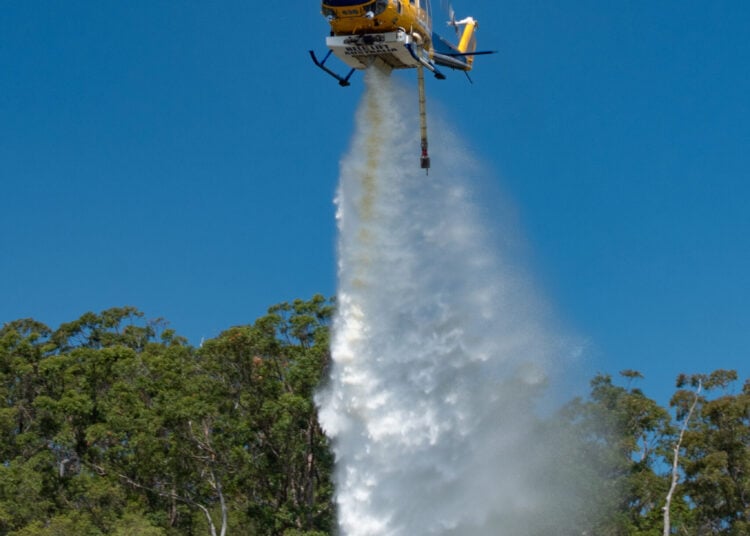History
Starting as an aircraft engineer with Australia's Ansett Airlines in the mid-1970s, John McDermott could not have imagined that a few decades later, the company he founded would be one of the leading aerial firefighting companies in Australia, with the largest Bell 214 fleet in the world.
The McDermott Aviation story started as John began flight training as a hobby in airplanes during his apprenticeship. After completing his apprenticeship with Ansett, knowing he loved aviation but didn't love working for an airline, it was time for a break, so in 1977 he and Linda, his wife, took off for Europe, Backpacking around to see the sights.
During a boat trip down the Moselle River at the age of 21, he saw a Bell 47 spraying grapevines and decided that that was what he wanted to do as a job. Knowing that helicopters were the more expensive option, he continued with his fixed-wing license to obtain experience in fixed-wing agricultural spraying before making the segway into helicopters.
Upon returning home, John found a Cessna 185, which he purchased sight unseen with his flight instructor. When they arrived at the aircraft in Cairns, it was discovered that it needed lots of work, which he completed, bringing it to airworthy status and using it to obtain his commercial pilot rating.
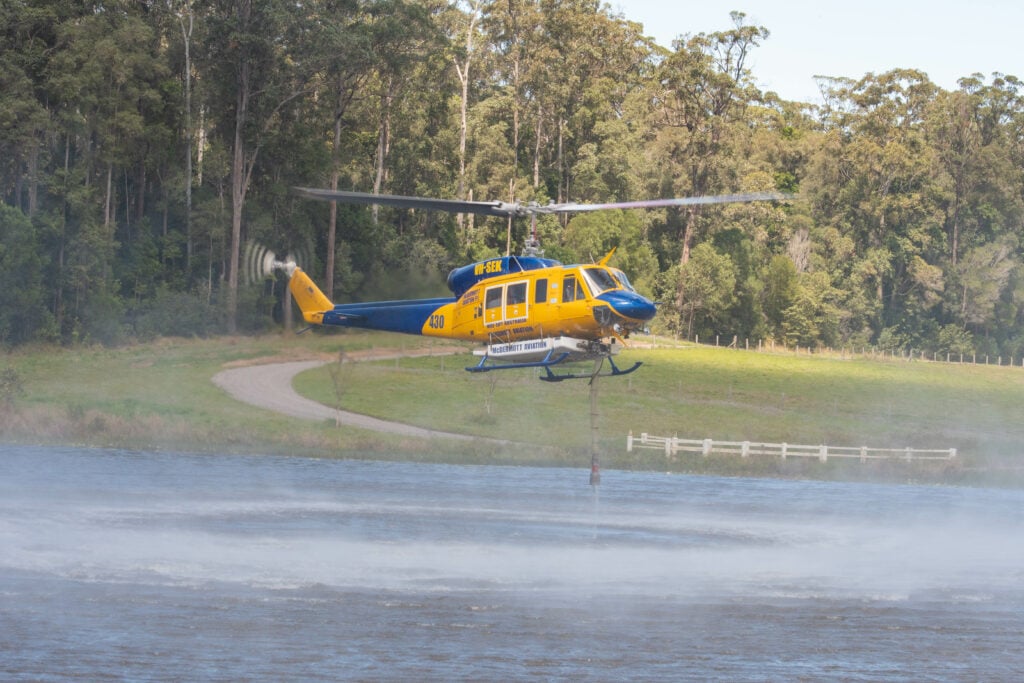
His first role in the Ag business was with Super Spray, a Victorian company owned by Roy Robertson, where he obtained his ag rating. McDermott then moved on to his next role, flying a Piper Pawnee and an Ag Wagon in Western Australia.
He returned to Victoria in 1980 for another spray season in the southern state before converting to helicopters as the first commercial pilot trained by Ron Newman and the now large-scale Moorabbin, Victoria-based helicopter training company Professional Helicopter Services (PHS) learning in the Schweitzer S300, which incidentally was also the same aircraft type that he completed his first spray job for after relocating to Queensland.
After converting his ag rating from fixed wing to helicopter, John began working for a company called Heli Work before eventually going out on his own in 1984 as McDermott Aviation - working as a contractor for East Coast Helicopters, which would see him work multiple spray seasons in Scotland as well as Australia.
In 1988, John continued contracting with Chopperline during Australia's World Expo before leasing the Scottish S-300s in 1990 and returning it to Australia to become the company's first aircraft under the banner of McDermott Aviation.
Starting Out
In 1991 the company commenced its first firefighting operations from its base in Cooroy, Queensland, in a Bell Jetranger using the spray tank with the dump doors, which in his admission, was "pretty ineffective" at the time but was better than nothing.
The company then continued to grow over the next several years, doing a mix of ag aviation, spraying fungicides and herbicides, mosquito spraying, and forestry work in addition to firefighting work, which the company still does today.
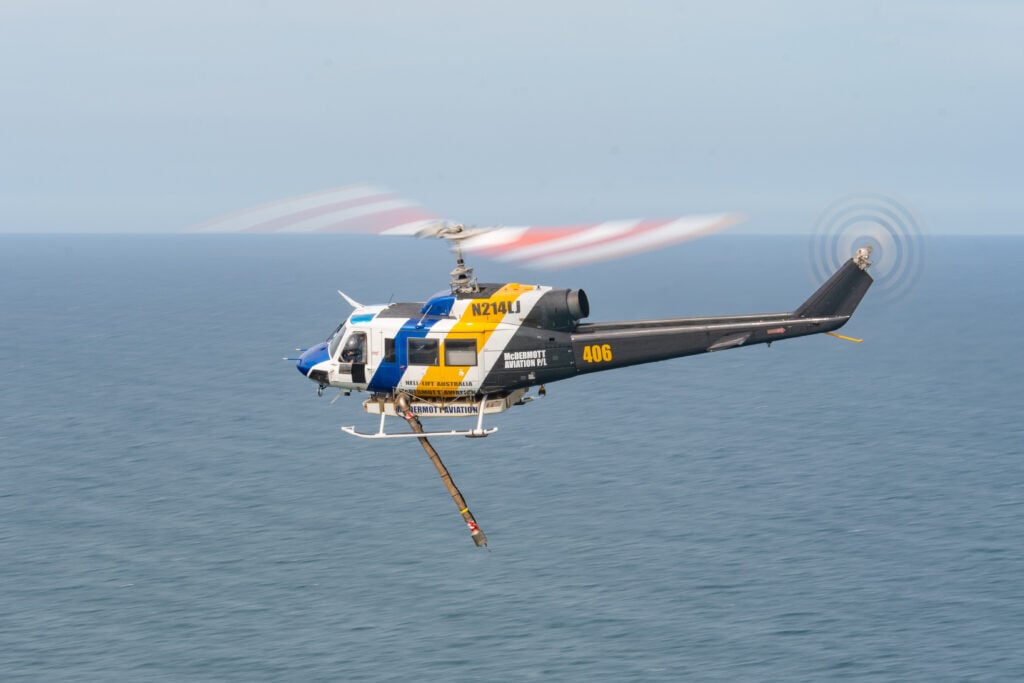
In 1996 the company started to obtain a lot more pre-planned forestry work, which led to the need to obtain larger aircraft to handle the workload, the first two of which were the TH-1F, the air force variant of the UH-1B, obtained from Davis Monthan Air Force Base the United States that began arriving in 1998, filled by a further five of the same aircraft, in addition to the four Soloy-Bell 47T aircraft the company used for ag spraying as the company continued its rapid expansion in the 1990s.
The new TH-1F aircraft were quickly fitted with Isolair spray tanks and put to work to keep up with the rapidly increasing demand to deal with noxious weed spraying in the country's north as the new larger airframes were able to do an area two and a half times bigger than the Bell 47T could cover in the same amount of time.
In 2000, fire seasons were escalating in a way not seen since the 1980s in Australia, specifically in New South Wales, which led to the first time that multiple assets from McDermott were requested to fight fires simultaneously. John quickly dispatched three of the company's Huey fleet, one with a fire tank and two with buckets to fight fires, putting hundreds of hours on each aircraft that year, which was soon repeated in 2001.
Meeting Goals
The increase in firefighting work was starting to impact the company's ability to meet goals in their existing forestry work, which meant further expansion for McDermott. John realized the need for something on the firefighting side that would be bigger than the Huey but smaller than the giant Erickson Air-Crane regarding water capacity and the ability to carry crew—settling on purchasing five Bell 214B helicopters from Oman, unintentionally starting the acquisition of a commercial fleet of Bell 214 B's that is now the largest in the world.
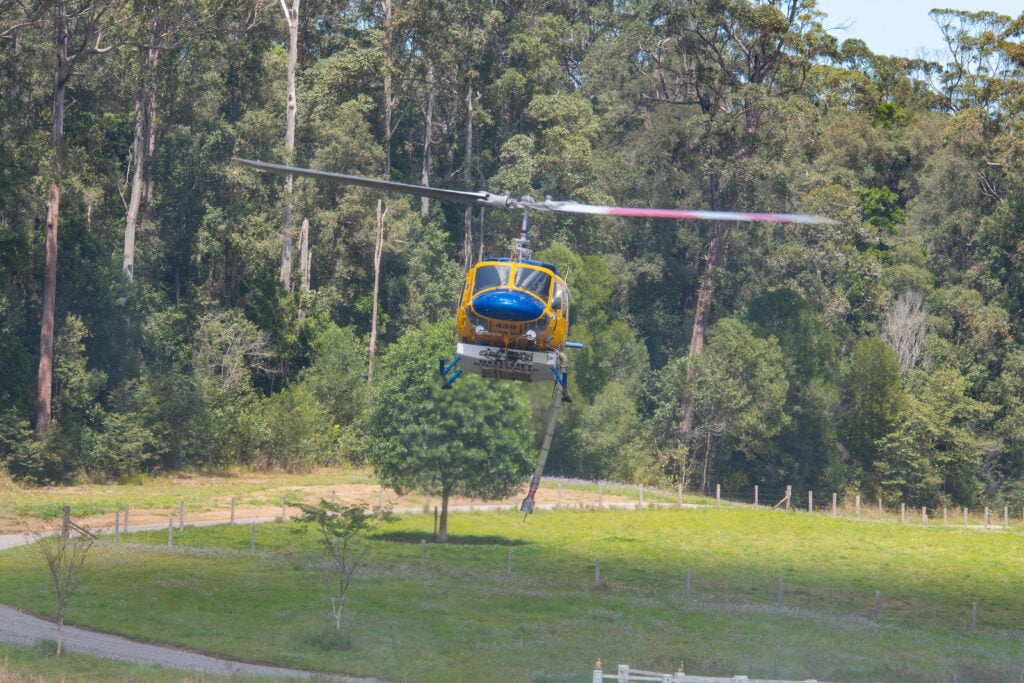 The acquisition of the 214B and the need for them to be effective pushed John and his friend Michael Powell from Isolair to design and build a purpose-built firefighting tank for the helicopter that is still in use today (>370,000 water drops to date) along with the Helitak tank used on some aircraft in addition to the Isolair tank. In addition to the tank, McDermott also developed and certified high skids for the 214B to accommodate sufficient ground clearance of the tank system.
The acquisition of the 214B and the need for them to be effective pushed John and his friend Michael Powell from Isolair to design and build a purpose-built firefighting tank for the helicopter that is still in use today (>370,000 water drops to date) along with the Helitak tank used on some aircraft in addition to the Isolair tank. In addition to the tank, McDermott also developed and certified high skids for the 214B to accommodate sufficient ground clearance of the tank system.
The additional work completed by John and his team was quickly rewarded when in 2003, McDermott Aviation was awarded five contracts for work in Victoria, New South Wales, and South Australia during the first contract awards given out by the newly stood-up National Aerial Firefighting Center (NAFC), which was created to award contracts and later to coordinate the distribution and operations of aerial assets around Australia.
The creation of NAFC and, in turn, firefighting contracts enabled operators to have the stability of solid financial support that could be counted on when spending several million dollars on new aircraft ahead of a fire season. In contrast, previously, the federal government at the time had no contract support, which made operators weary of spending money without guaranteeing a return on their investment.
Never one to keep an aircraft idle, the rapid expansion of the McDermott fleet was noticed, and requests were made for their aircraft to assist the fire season in 2004 in Spain, Canada, and Portugal.

The 2005 season, however, saw NAFC award more contracts to offshore operators, allowing McDermott further overseas expansion, sending an aircraft to New Caledonia, a contract that lasted for fifteen years; the company also added work in Indonesia in 2015 and fire operations in Greece in 2020.
Challenges
As with any growing company, especially one that moves large pieces of equipment around the world, McDermott Aviation is familiar with difficulties in logistics, the largest of late being the cost of freighting aircraft around the world. "We used to get upset about it costing us $80,000 to air freight a Bell 214B in a 747 halfway around the world, but prices have skyrocketed recently, where it can cost us $500,000 to sea freight an aircraft now from our base to an overseas location," said John.
Overseas Deployments
With Australian pilots operating aircraft worldwide, COVID-19 posed a significant problem with staffing, requiring crews to stay overseas for an entire season. Now that issues with COVID have passed, staff now spend four to six weeks at a time on location. Additionally, some chose to stay the entire time, and some took the opportunity to bring their families with them for the entire duration of tours in Greece for the fire season.
Fleet
In addition to five Bell 47 T's and five Bell 206L3, eight AS355s that can work ag or provide imagery or air attack duties, and eight AS365s working search and rescue-based missions SIG ops and firefighting at various locations around Australia equipped with 1000 liter tanks. McDermott Aviation now has fifteen Bell 214B aircraft and fourteen Bell 214ST models, comprising the largest fleet of Bell 214s in the world owned by a single operator. The Iranian Military is the only other operator in the world with more aircraft. McDermott Aviation also houses the most extensive spares inventory for both 214 models in the world at their Cooroy-based headquarters, where most of all Heavy maintenance work is completed. Sunshine coast facility is responsible for all Airbus fleet maintenance, with the company having a significant MRO operation in Jandakot, Western Australia, to maintain the West Australian-based fleet. We have a well established field maintenance capability to provide all in-field support when aircraft are at work overseas.

Staffing
While pilots in Australia require different hours to qualify for specific roles, John McDermott says that his pilots are very much a mixed bag, with about 90% of his ag pilots being trained in-house to do ag work after working commercially elsewhere in the industry for one to two thousand hours before joining the company. "You have to want to do ag passionately. Flying ag is not for people in this industry that want to build hours," John stated.
Safety
Ag work and aerial firefighting are treated very much the same in the eyes of safety by McDermott Aviation in that both sectors of the business put just as much work into checking each area they fly for obstacles and anything that could cause adverse results. It may be ground firefighters at risk and obstacles like powerlines. In contrast, in ag, company pilots must perform reconnaissance flights, not just for obstacles like powerlines, but proximity to other fields, wildlife, or even national parks and protected species.
"The workload for ag is exceptionally high. So again, it's something you've got to want to do. That's why wanting to do aerial firefighting should be the same. In aerial firefighting, there are fewer flying hours in a day. In firefighting, you get big breaks and can be on different fires, so it's a different level of stress and risk. We train our aerial firefighting guys the same way we train our ag pilots. We ensure that you treat the fireground like an ag spraying contract. So you do a thorough survey of the area to find as many obstacles as you can. We spend as much time as needed in a training environment to mitigate dangerous risks."
Training
Unlike training in the United States, check rides are not completed by a government agency like the USFS or state agencies in Australia, so the operator in Australia gives the bulk of the training, other than an aerial firefighting rating. Companies like McDermott take that responsibility seriously, putting each new aerial firefighting pilot through a complete syllabus of training requirements for each aircraft, utilizing both buckets and tanks for training so that pilots are well-rounded on all aircraft, culminating with a yearly checkride with John McDermott himself for each pilot to evaluate each pilots skills and competency continually.
Maintenance
Maintenance can be a complex operation for a company that operates in multiple countries each year. Still, to accomplish this, McDermott employs fifty airframe mechanics, avionics technicians, painters, and licensed aviation mechanics to keep the wheels turning. Some of these staff are deployable with the aircraft when they are dispatched to overseas destinations throughout the year, while the majority are based at the company's Cooroy headquarters.
"Maintenance staffing is our weakest link right now," said John, who says the company still needs another twenty mechanics to get staffing levels where we would like to see them. This is an industry-wide problem. At McDermott, we are doing our bit with training new apprentices and even starting a training academy."
"The problem we have is finding mechanics that are passionate about the job and about what we do and that don't just treat it like a job. Being at a firebase can be hard and boring at times, but we need people that are committed to what we do," said John.
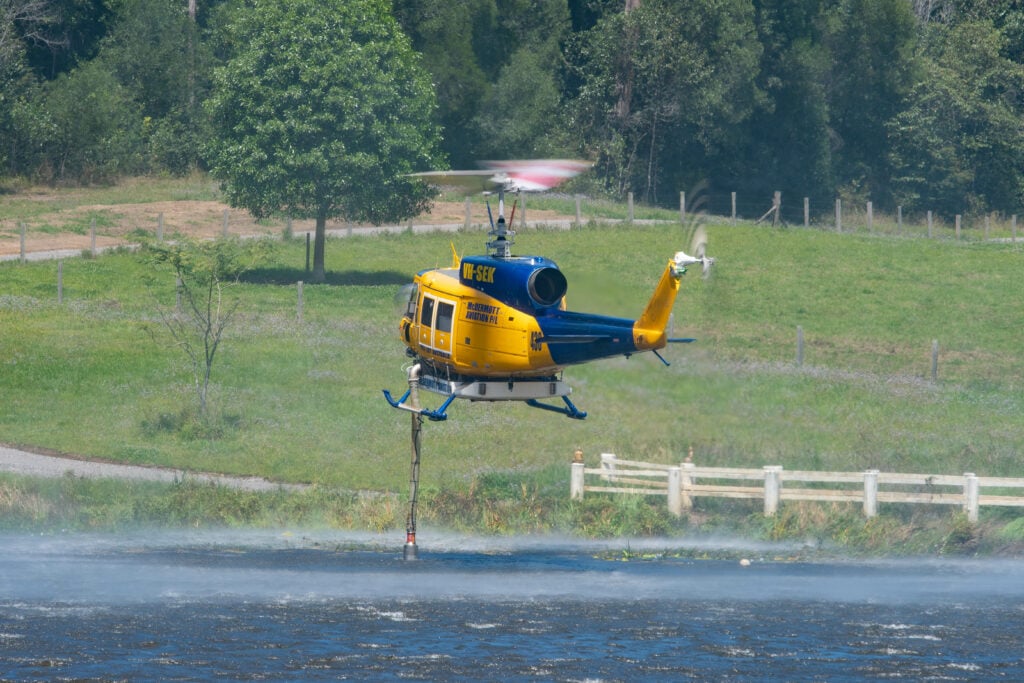 Another issue the company faces is difficulties in getting mechanics who have completed a four-year apprenticeship licensed or licensing overseas qualified applicants as Australia's CASA regulatory board continues to make the task of becoming licensed more and more complex and expensive every year, leading to people giving up the industry for other endeavors due to the difficulty and driving new talent away from the field.
Another issue the company faces is difficulties in getting mechanics who have completed a four-year apprenticeship licensed or licensing overseas qualified applicants as Australia's CASA regulatory board continues to make the task of becoming licensed more and more complex and expensive every year, leading to people giving up the industry for other endeavors due to the difficulty and driving new talent away from the field.
U.S Expansion
To offset some of the issues of lack of mechanics in Australia and to offset the cost of moving assets around the world, one of the things that McDermott Aviation has done to mitigate some of those costs is to open a maintenance base in Andalusia, Alabama recently. The maintenance shop in Alabama will employ American maintainers to house and maintain the McDermott fleet of 214STs. The U.S. market is easier to find mechanics qualified to work on the 214ST, according to John, who hopes the U.S. location will solve several issues and reduce the cost of moving aircraft to overseas locations in the future.
 The location at the South Alabama Regional Airport is already in operation and still looking for more maintenance staff and will eventually house the company's 214ST fleet in the near future.
The location at the South Alabama Regional Airport is already in operation and still looking for more maintenance staff and will eventually house the company's 214ST fleet in the near future.
The Future
For a company like McDermott Aviation, headed by John McDermott, who is self admittedly not someone who takes well to retired life, there is always something else on the horizon. John states that he still enjoys the challenges of groundbreaking technology and doing things that have never been done before in the industry, like their work with the ST fire tank and now saltwater scooping operations in addition to the new MRO facility in Alabama that will keep him and the crew at McDermott very busy into the near future.

